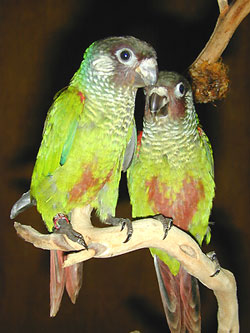Conure - White Eyed
Scientific Name: Aratinga leucophthalma
Mon, 30th June, 2025 - 8:33 pm GMT
Sponsor Ads:

Alternative Name
Scientific Name: Aratinga leucophthalmaBasic Info
White-eyed Conures have predominantly green plumage and grow to a length of about thirteen inches. The breast and abdomen are slightly lighter in color than the rest of the White-eyed Conure. These birds have a spattering of red feathers over their heads, and get their name from the white skin around their periopthalmic rings. Their irises are brown and their bills are horn-colored. White-eyed Conures have red feathers at the bends and edges of their wings, and this coloring continues in the lesser, outer, under-wing coverts. The larger under-wing coverts are a bright yellow and the undersides of the tail and wings are a dull yellow-green. Their wings are about seven inches in length. White-eyed Conures have gray feet.
Health
A White-eyed Conure needs a large cage, especially if it is not going to be let out for extended periods. Many people find their Conures enjoy spending time on a perch atop the cage or in a play pen. White-eyed Conures need plenty of toys and chew toys to prevent them from becoming bored. White-eyed Conures are intelligent, social birds who need a very large amount of attention from you. If you do not have plenty of time, patience, and affection to devote to your bird, you may want to consider a different pet. Breeding Although they are not commonly bred, White-eyed Conures are easy to breed in captivity. Provide your birds with a nesting box of about one foot square and one foot high. Sometimes, White-eyed Conures will breed twice, having clutches in quick succession. A typical White-eyed Conure's clutch consists of three to four eggs, which will incubate for about 26 days before they hatch. White-eyed Conures leave the nest at about eight weeks of age. These immature Conures lack the red coloration of adults and their irises are much darker than those of adults. The White-eyed Conure has an average lifespan that ranges bteween 25 and 30 years.Habitat
Their range is huge, comprising the Guyanas, Bolivia, Surinam, Brazil, Paraguay, eastern Colombia, eastern Venezuela, northeast Uruguay and northern Argentina.Behavior
Little known to many aviculturists, the White-eyed Conure is a well-kept secret. These lovely, affectionate pets will provide themselves and you with hours of entertainment. White-eyed Conures are loveable, entertaining little birds. They can be taught tricks and will mimic other birds. Many can also learn to say a few words and phrases. A White-eyed Conure needs a large cage, especially if it is not going to be let out for extended periods. Many people find their Conures enjoy spending time on a perch atop the cage or in a play pen. White-eyed Conures need plenty of toys and chew toys to prevent them from becoming bored. In addition, make sure your White-eyed Conure has fresh water at all times. With patience and lots of attention, your White-eyed Conure will form a strong, affectionate bond with you.Origin
VenezuelaHistory
White-eyed Conures are native to South America. Their range is huge, comprising the Guyanas, Bolivia, Surinam, Brazil, Paraguay, eastern Colombia, eastern Venezuela, northeast Uruguay and northern Argentina. The White-eyed Conure got its first official recognition from P.L.S. Muller in 1778. Although these birds remain rare in aviculture, they have a good following among Conure enthusiasts and are bred easily in captivity.Common Foods
Feed your White-eyed Conure a good pellet diet or basic seed mix, and be sure to provide fresh fruits, vegetables and legumes to supplement your bird's meals.Sponsor Ads:
"Love looks not with the eyes, but with the mind, and therefore is winged Cupid painted blind". -- A Midsummer Night's Dream Act I, Scene I
Conure - White Eyed
Coded by: BGID® | ALL RIGHTS RESERVED Copyright © 2000-2025
Disclaimer | Privacy | Report Errors / Contact | Credits









